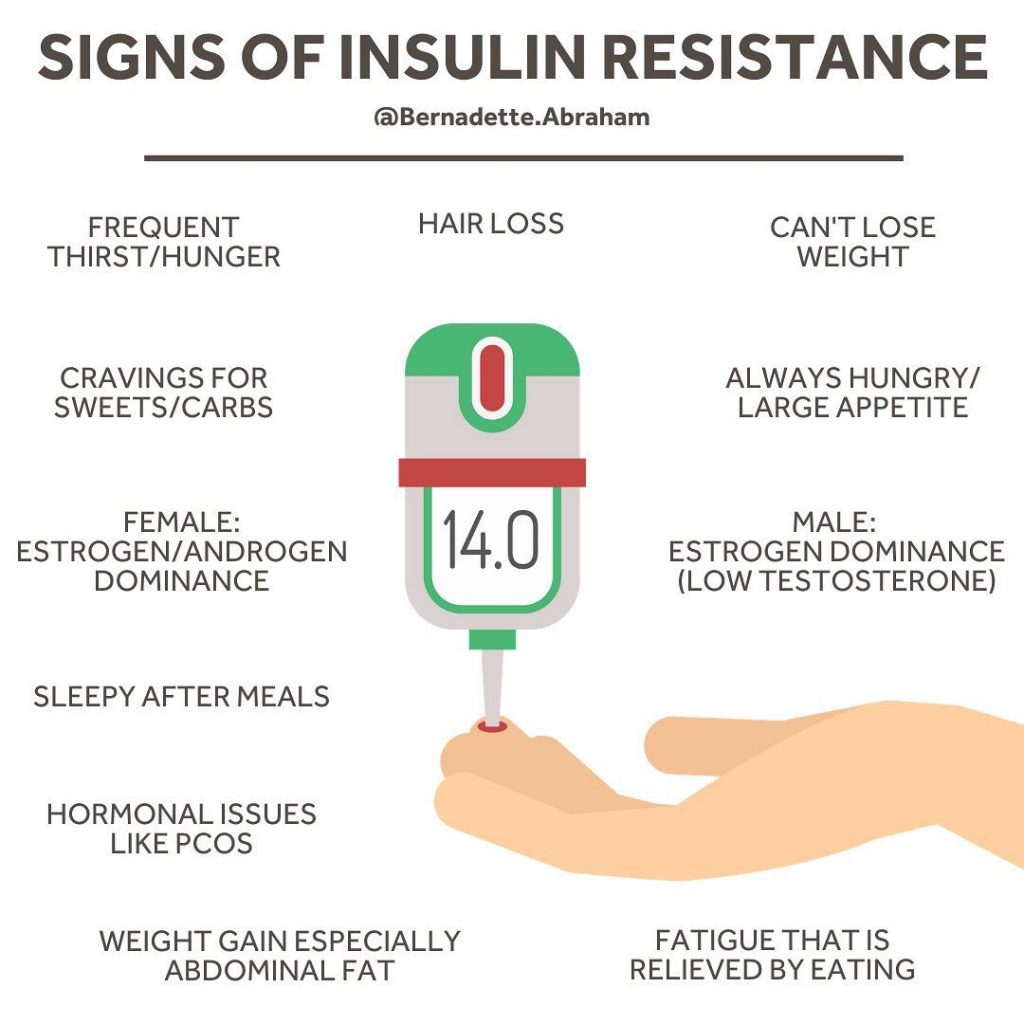
Do you crave something sweet in the afternoon, get “hangry” if you miss a meal or have any of the other symptoms listed in the picture below?
It may be a good idea to rule out “insulin resistance” – a condition when cells no longer respond to insulin’s action, which is to get glucose (sugar) out of the blood and into the cell.
This process doesn’t happen overnight; it takes years and if left unaddressed, can eventually lead to type 2 diabetes.
How does it happen?
It typically starts with a Standard American Diet causing large spikes of blood sugar multiples times per day.
Those spikes of higher blood sugar and insulin cause energy swings and cravings for more and more refined and carbohydrate-rich foods.
Over time, cells become sick and tired of having to process so much sugar and make the pancreas work even harder to secrete more and more insulin to force cells into accepting the excess sugar.
This is why testing fasting insulin is one of the helpful markers in identifying insulin resistance which typically begins 5 to 10 years before other diabetic manifestations. An optimal range is between 5 to 7 mIU/L.

Anything higher indicates insulin resistance and levels much lower can indicate pancreatic dysfunction or unmanaged Type 2 Diabetes.
As a result, insulin resistant cells cause a person to suffer from low energy; organs and the cardiovascular system suffer from damaging effects of excess sugar, and the body stores more and more fat.
What can you do about it? Address the basics first:
✔️Manage stress (stress increases cortisol, and therefore blood sugar!)
✔️Optimize sleep & circadian rhythm
✔️Avoid processed, packaged, refined foods
✔️Balance your meals (fat, unrefined carbs, protein, veggies/fiber)
✔️Strength train (helps make cells more sensitive to insulin)
I’m not gonna sugarcoat it – insulin resistance and Type 2 diabetes are totally reversible but it takes SERIOUS dietary/lifestyle modifications, and targeted supplementation.
So step 1️⃣ Test and address diet for a MINIMUM of 3 months to give the organs a well-deserved vacation, then re-test.
Meals should include plenty of fibrous veggies, quality proteins and healthy fats. Limit grains to ½ cup per day (cooked) and root vegetables to 1 cup per day.
2️⃣ ZERO SWEETENERS and flour of any kind (bye bye bread, cereal & pasta). Fruits are the exception; 1-2 low-glycemic whole fruits per day or 1 cup cut up.
3️⃣ Control inflammation. Replace inflammatory vegetable oils like canola and corn oils with extra virgin olive oil and coconut oil.
Also incorporate anti-inflammatory foods rich in omega-3 (e.g. sardines, flax seeds, walnuts) and antioxidants (e.g. curcumin, garlic, ginger), and eliminate food sensitivities.
4️⃣ Prioritize sleep to normalize insulin levels. Avoid eating at least 2 hours before bed, sleep by 10/10:30pm and wake up at consistent times.
5️⃣ Address stress. Ongoing high cortisol can raise blood sugar and yes, cause insulin resistance! Remember stress can be mental/emotional but also physiological (e.g. heavy metal toxicity, fungal overgrowths).
6️⃣ Supplement considerations: magnesium, vitamin D, chromium, biotin, alpha lipoic acid, l-carnitine all play a role with insulin management.
And we can’t forget inositol, which also alleviates PCOS in women by improving insulin resistance and finally, berberine – a phytonutrient proven to be just as effective at regulating blood sugar in Type 2 diabetes as the drug metformin (minus side effects)!

You might ask about the best diet to help reverse insulin resistance.
Well here’s the thing. Even the best functional medicine professionals cannot agree on THE best diet because ultimately, it boils down to bio-individuality, which means:
✔️Your genetics
✔️What you have access to
✔️What you can afford
✔️What you can prepare, palate, and ultimately sustain with pleasure and commitment that reduces sugar and ectopic fat, allows the liver & pancreas to recover, and stops the cycle of dysfunction.
I think the biggest confusion around blood sugar control is carbs (see above picture) so let’s start there.
Foods vary in their carbohydrate density (i.e. percentage of the food that is made up of carbs minus fiber) and how quickly they are digested and absorbed to affect blood sugar.
The more carb dense, the easier it is for the body to convert it into sugar. Fiber plays a key role and so does bio-individuality!
Whole grains for example are carb dense and can spike blood sugar quickly in some people but not in others.
The type of grain also makes a difference (ex. rye is slower, whole wheat is faster acting). You can begin to see all of the possible nuances.
In my experience however, including plenty of non-starchy vegetables, moderate amounts of protein and fat (again, so many nuances), and avoiding dense/fast acting carbs is a helpful guide to reverse insulin resistance.
👉🏻Here’s a practical example:
✅Breakfast: Eggs, bowl of leafy greens, avocado, sprinkle of pine nuts
✅AM Snack: Green tea & 10 almonds (for high fasting insulin or medication induced hypoglycemia tendency)
✅Lunch: Mixed green salad, olives, lemon/EVOO dressing, black beans, grilled chicken, sunflower seeds
✅PM Snack: Green tea, apple with hummus (for high fasting insulin or medication induced hypoglycemia tendency)
✅Dinner: Baked salmon, sautéed spinach with onion and sweet potato cubes
Hope this helps. Please share❤️

Leave a Reply